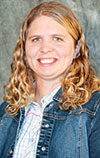The new South Dakota State University Cow-Calf Unit, located about 2.5 miles northwest of the old facility, consists of three buildings and 12 10-acre paddocks. Cody Wright, SDSU professor of animal science and faculty supervisor of the cow-calf unit, says the unit will do more than house the university’s cow herd.
“It’s actually set up to facilitate many different types of cattle,” Wright says. “It’s at the cow-calf unit, but we wanted to make it as flexible as possible.”
The new facility replaces the old unit that was built in the 1950s. While the old one functioned well for many years and could be adapted to a commercial operation, the facility did not have the capabilities for conducting teaching and research needed in a university setting.
Plans for a new facility started about six years ago. A fire that destroyed part of the old building in 2012 helped push those plans forward. Fundraising for the $4.1-million facility began in 2010 with auctions, the “Send a Cow to College” program that encouraged producers to donate a cull animal to sell at a sale barn to benefit the effort and various private individuals and companies. Construction began in April 2015.
Since construction was ongoing through the summer and fall, the university’s farm department could not store any feed at the new facility, so no animals are being housed there yet.
This summer, they will be able to store feed in the new commodity shed, which contains four bays for different kinds of feed. They can also store feed in ag bags on a 50-foot-by-150-foot pad or in two large bunker silos.
The main building houses an 80-seat theater-style classroom. It also includes some office space, storage and room for a simple laboratory setup. The working facility with a Bud Box system is also housed there.
“We’ve elected to go with the Bud Box for [a couple of] reasons; one, a couple of us are intrigued with how they work and really like how they work.

Two, the ruminant nutrition center, the feedlot, has the Temple Grandin-type system,” Wright says. “We wanted to talk about animal handling; we can let students go out there and literally work cattle in each of those systems, let them choose.”
When they were working on the design, they debated about what kind of working facility to install. They had seen the Bud Box in practice on commercial operations, and the design team confirmed they should put that system in, especially since students can experience another system at the feedlot unit.
“We can have the contrast between the two types of facilities and let the students experience both,” he says.
Wright says having the working facility indoors means students or producers visiting the facility can work cattle in a heated area, making it more comfortable during cold winter months.
The building also includes an area with a concrete drive down the center with gravel on either side that can be used for maternity pens during calving season, a fitting chute area for students during their livestock expo, Little International and things like an A.I. school or judging school.
Right outside the building are four hospital pens set up to be biosecure with space between them and no shared waterers or feeders, and six display pens for the university’s annual bull sale.
The third building at the new facility is the research facility. Much of that building is a monoslope barn featuring Insentec feeders. The feeders came from the Netherlands and are at the facility but have not been installed yet. Wright says the company wanted to wait to install them when the weather started to warm up for spring.
“Those feeders allow us to not only collect individual feed intake but also apply different treatments to different animals within a pen,” Wright says.
The monoslope building has a curtain on the north and is open to the south. Twelve pens will have 12 feeders and two Insentec waterers. Those waterers will allow them to track water intake from any animal.
With the waterers, they can also use a dose meter to apply a treatment to the water or replicate a high-sulfate water situation like many producers in the state deal with.
Wright says they have designed the research building to mimic a Sandhills Calving System.
“We’ve designed this to essentially do the same thing but do it in drylot pens. We’ll be able to model that and see how it works, and producers can take a look and see what it takes to make that happen,” he says.
Immediately southwest of the monoslope are 12 paddocks that are 10 acres each. Six of them are seeded with cool-season grasses, and the other six contain warm-season grasses.
The old facility housed the university’s 110 females. While the new facility will be home to the cow herd and the university’s spring bull sale, Wright says they will also use the facility for different kinds of cattle research.
“It’ll give us more to do if we wanted to have steers, more cattle that don’t make the bull sale or more heifers; whatever the case might be, we’ll have a little bit more grass to expand somewhat,” he says.
While the new facility will make an impact on current and future Jackrabbits, Wright hopes producers and others in the industry will make use of the facility.
“We hope everybody wants to come out and use it. It’s also open for Extension, different organizations, so if a feed company or a pharmaceutical company or vet clinic wanted to have a field day there or a producer meeting, we’d absolutely be open to letting them use it,” Wright says. “It’s going to be pretty multipurpose.” 
![]()
Wendy Sweeter is a freelance writer based in South Dakota.
PHOTO 1: The new SDSU Cow-Calf Unit includes a monoslope building, commodity shed and a building for working cattle.
PHOTO 2: The new Bud Box in the working facility. Photos courtesy of South Dakota State University.







